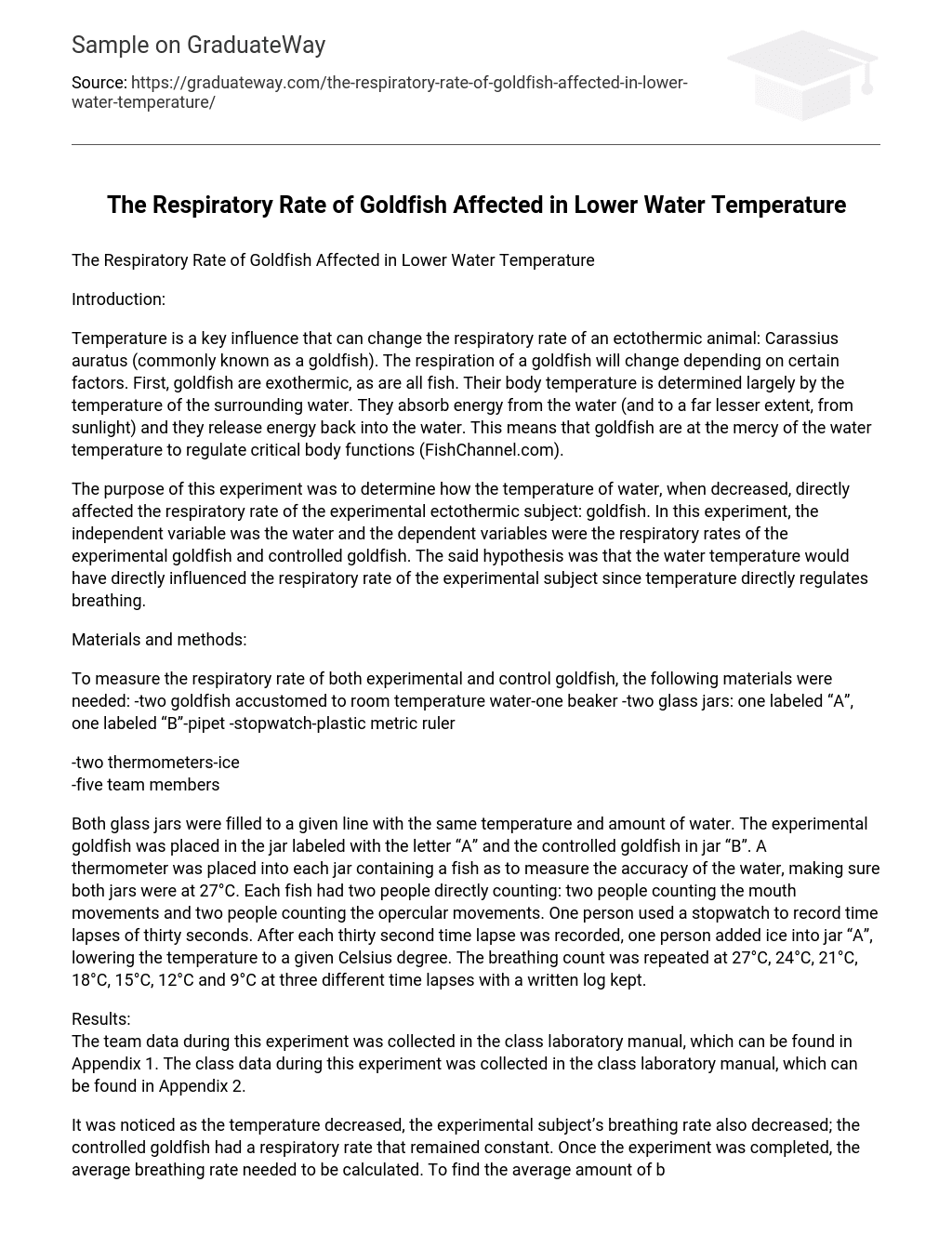Introduction:
Temperature is a key influence that can change the respiratory rate of an ectothermic animal: Carassius auratus (commonly known as a goldfish). The respiration of a goldfish will change depending on certain factors. First, goldfish are exothermic, as are all fish. Their body temperature is determined largely by the temperature of the surrounding water. They absorb energy from the water (and to a far lesser extent, from sunlight) and they release energy back into the water. This means that goldfish are at the mercy of the water temperature to regulate critical body functions (FishChannel.com).
The purpose of this experiment was to determine how the temperature of water, when decreased, directly affected the respiratory rate of the experimental ectothermic subject: goldfish. In this experiment, the independent variable was the water and the dependent variables were the respiratory rates of the experimental goldfish and controlled goldfish. The said hypothesis was that the water temperature would have directly influenced the respiratory rate of the experimental subject since temperature directly regulates breathing.
Materials and methods:
To measure the respiratory rate of both experimental and control goldfish, the following materials were needed: -two goldfish accustomed to room temperature water-one beaker -two glass jars: one labeled “A”, one labeled “B”-pipet -stopwatch-plastic metric ruler
-two thermometers-ice
-five team members
Both glass jars were filled to a given line with the same temperature and amount of water. The experimental goldfish was placed in the jar labeled with the letter “A” and the controlled goldfish in jar “B”. A thermometer was placed into each jar containing a fish as to measure the accuracy of the water, making sure both jars were at 27°C. Each fish had two people directly counting: two people counting the mouth movements and two people counting the opercular movements. One person used a stopwatch to record time lapses of thirty seconds. After each thirty second time lapse was recorded, one person added ice into jar “A”, lowering the temperature to a given Celsius degree. The breathing count was repeated at 27°C, 24°C, 21°C, 18°C, 15°C, 12°C and 9°C at three different time lapses with a written log kept.
Results:
The team data during this experiment was collected in the class laboratory manual, which can be found in Appendix 1. The class data during this experiment was collected in the class laboratory manual, which can be found in Appendix 2.
It was noticed as the temperature decreased, the experimental subject’s breathing rate also decreased; the controlled goldfish had a respiratory rate that remained constant. Once the experiment was completed, the average breathing rate needed to be calculated. To find the average amount of breaths taken by each fish, the sum of the total amount of breaths was divided by the number of trials (three). To find the counts per minute (CPM), the average was multiplied by two (Table 1.1) To determine the change in breathing rate, the temperature of the water in which the experimental subject was in, was decreased by continually adding ice.
For the team experiment, the average mouth movement rate for the experimental goldfish fluctuated from a noteworthy change of 63.6 to 28 breaths per minute. The average operculum movement rate for the said goldfish fluctuated from a noteworthy change of 79 to 22.6 breaths per minute.
For the team experiment, the average mouth movement rate for the controlled goldfish stayed constant at around 70 to 72.3 breaths per minute. The average operculum movement rate for the said goldfish had some change at around 66.3 to 80 breaths per minute.
The average outcome of the experiment as a class showed the decrease in water temperature for the experimental goldfish can be seen in Appendix 2. The average mouth movement rate for the experimental goldfish fluctuated from 135.5 to 40.5 breaths per minute. The average operculum movement rate for the said goldfish fluctuated from 126.5 to 38.75 breaths per minute.
The average outcome of the experiment as a class showed the constant in water temperature for the controlled goldfish, seen in Appendix 2. The average mouth movement rate for the controlled goldfish remained fairly constant at 103 to 105 breaths per minute. The average operculum movement rate for the said goldfish remained fairly constant at 107.75 to 113.5 breaths per minute.
Discussion:
The data gathered afforded evidence that the dependent variable was the respiratory rate of both experimental and controlled goldfish, which is effected by water temperature. Evidence showed there was significant a difference in the respiratory rate of the experimental subject during decreased temperatures.
Goldfish have a one-way flow respiratory system which allows them to pump water through their operculum (gills) and back into water, absorbing oxygen. In keeping watch of both the movements in the mouth and operculum of the experimental subject, results revealed that decrease in temperature resulted in slower breathing. This transpired because goldfish are ectotherms and when their surrounding temperature(s) decrease, their heart pumps slower resulting in the goldfish’s respiratory rate to lessen.
Perhaps had the experimental subject been larger or smaller, its mass would have changed the breathing rate, however both experimental and control subjects were not weighed and judging by the eye, seemed to be similar in size. Additionally, had velocity or light been a variable, it could have altered the respiratory rate in the experimental and controlled subjects.
Literature cited:
Ramel, Gordon. “Gills: Gaseous Respiration in Fish”. Earth Life Web. http://www.earthlife.net/fish/gills.html Quinlan, Sarah. “The Respiratory System of a Goldfish”. The Nest. http://pets.thenest.com/respiratory-system-goldfish-3745.html Meyer, Stephen M. “Proper Goldfish Water Temperatures: Warmer water can have a number of effects on goldfish in ponds and in aquariums.” FishChannel.com. http://www.fishchannel.com/freshwater-aquariums/species-info/goldfish/high-temps.aspx





